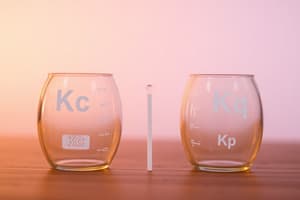Podcast
Questions and Answers
In an equilibrium calculation, which states of matter are excluded from the $K_c$ expression?
In an equilibrium calculation, which states of matter are excluded from the $K_c$ expression?
- Liquids and aqueous solutions
- Gases and solids
- Solids and liquids (correct)
- Gases and aqueous solutions
The quantity of a solid reactant affects the value of the equilibrium constant, $K_c$.
The quantity of a solid reactant affects the value of the equilibrium constant, $K_c$.
False (B)
If the initial amount of substance A is 6 moles and the equilibrium amount is 2 moles, how many moles of A have reacted?
If the initial amount of substance A is 6 moles and the equilibrium amount is 2 moles, how many moles of A have reacted?
4
If $K_c$ is greater than 1, then the ______ are dominant at equilibrium.
If $K_c$ is greater than 1, then the ______ are dominant at equilibrium.
Match the $K_c$ value to the equilibrium condition:
Match the $K_c$ value to the equilibrium condition:
What is the formula for calculating concentration?
What is the formula for calculating concentration?
If 5 moles of A react, and the ratio of A to C is 1:2, then 5 moles of C are produced.
If 5 moles of A react, and the ratio of A to C is 1:2, then 5 moles of C are produced.
A container has a volume of 4 cubic decimeters. If there are 8 moles of substance C at equilibrium, what is the concentration of C?
A container has a volume of 4 cubic decimeters. If there are 8 moles of substance C at equilibrium, what is the concentration of C?
In the $K_c$ expression, exponents are used to represent the ______ coefficients in the balanced equation.
In the $K_c$ expression, exponents are used to represent the ______ coefficients in the balanced equation.
Match the change in moles to the corresponding effect:
Match the change in moles to the corresponding effect:
What does a $K_c$ value of less than 1 indicate about the equilibrium?
What does a $K_c$ value of less than 1 indicate about the equilibrium?
If the stoichiometric coefficients for A and C are both 2, the $K_c$ expression will not have exponents.
If the stoichiometric coefficients for A and C are both 2, the $K_c$ expression will not have exponents.
If the concentration of C at equilibrium is 6 mol/dm and the concentration of A at equilibrium is 3 mol/dm, what is the $K_c$ value?
If the concentration of C at equilibrium is 6 mol/dm and the concentration of A at equilibrium is 3 mol/dm, what is the $K_c$ value?
At equilibrium, if 3 moles of A remains in a reaction where initially there were 7, then ______ moles of A reacted.
At equilibrium, if 3 moles of A remains in a reaction where initially there were 7, then ______ moles of A reacted.
Match each component of the concentration formula.
Match each component of the concentration formula.
In an equilibrium reaction, 8 moles of A were initially present. At equilibrium, only 3 moles remain. How many moles of A reacted to reach equilibrium?
In an equilibrium reaction, 8 moles of A were initially present. At equilibrium, only 3 moles remain. How many moles of A reacted to reach equilibrium?
If the volume of the container increases, the concentration of the substances will also increase, assuming the number of moles remains constant.
If the volume of the container increases, the concentration of the substances will also increase, assuming the number of moles remains constant.
What is the $K_c$ expression for a reaction where A converts to C, assuming both have a stoichiometric coefficient of 1?
What is the $K_c$ expression for a reaction where A converts to C, assuming both have a stoichiometric coefficient of 1?
If a reaction mixture contains only reactants initially, then the initial moles of ______ are assumed to be zero.
If a reaction mixture contains only reactants initially, then the initial moles of ______ are assumed to be zero.
Match the volume (in cubic decimeters) with the corresponding concentration of a substance, given it has 4 moles.
Match the volume (in cubic decimeters) with the corresponding concentration of a substance, given it has 4 moles.
Flashcards
What is K_c?
What is K_c?
A measure of the relative amounts of reactants and products at equilibrium.
Why are solids excluded from K_c calculations?
Why are solids excluded from K_c calculations?
Solids do not affect equilibrium because their concentration remains constant.
How do you determine moles of A reacted?
How do you determine moles of A reacted?
Moles of A initially present minus moles of A at equilibrium.
What is a stoichiometric ratio?
What is a stoichiometric ratio?
Signup and view all the flashcards
How do you calculate concentration?
How do you calculate concentration?
Signup and view all the flashcards
Which states of matter are included in K_c?
Which states of matter are included in K_c?
Signup and view all the flashcards
What is the K_c expression?
What is the K_c expression?
Signup and view all the flashcards
What does K_c = 1 mean?
What does K_c = 1 mean?
Signup and view all the flashcards
What does K_c > 1 mean?
What does K_c > 1 mean?
Signup and view all the flashcards
What does K_c < 1 mean?
What does K_c < 1 mean?
Signup and view all the flashcards
Study Notes
KC Calculation Overview
- The lesson focuses on another equilibrium constant ($K_c$) calculation.
- The experiment starts by placing 6 moles of substance A into a container.
- Substance B is also added, but its quantity is unknown and irrelevant because it is a solid.
- Solids do not affect equilibrium calculations.
- At equilibrium, 2 moles of substance A remain.
- The goal is to determine the $K_c$ value for the reaction.
Determining Moles Reacted
- To go from the initial state to equilibrium, a reaction takes place.
- 4 moles of A must have reacted during the reaction, since 6 moles initially becomes 2 moles at equilibrium (6 - 4 = 2).
- The initial moles of C are assumed to be 0.
- According to the balanced equation, the substance A to the substance C ratio is 1:1.
- If 4 moles of A reacted, then 4 moles of C were produced.
- Therefore, the change in moles of C is +4.
- The moles of C at equilibrium is 4 (0 + 4 = 4).
Calculating Concentrations
- The volume of the container is 2 cubic decimeters.
- Concentration is calculated using the formula: $c = \frac{n}{v}$.
- The concentration of A at equilibrium is $\frac{2}{2} = 1$ mol/dm³.
- Substance B is ignored in concentration calculations because it is a solid.
- The concentration of C at equilibrium is $\frac{4}{2} = 2$ mol/dm³.
Equilibrium Constant Calculation
- The $K_c$ expression is $K_c = \frac{[C]}{[A]}$.
- Solids and liquids are excluded from the $K_c$ expression, only gases and aqueous solutions are included.
- There are no exponents in the $K_c$ expression because the stoichiometric coefficients for A and C are both 1.
- $K_c = \frac{2}{1} = 2$.
Interpreting the $K_c$ Value
- When $K_c = 1$, the concentrations of products and reactants are equal at equilibrium.
- When $K_c > 1$, the products are dominant at equilibrium.
- When $K_c < 1$, the reactants are dominant at equilibrium.
- Because $K_c = 2$, the products are dominating the reaction.
Studying That Suits You
Use AI to generate personalized quizzes and flashcards to suit your learning preferences.




